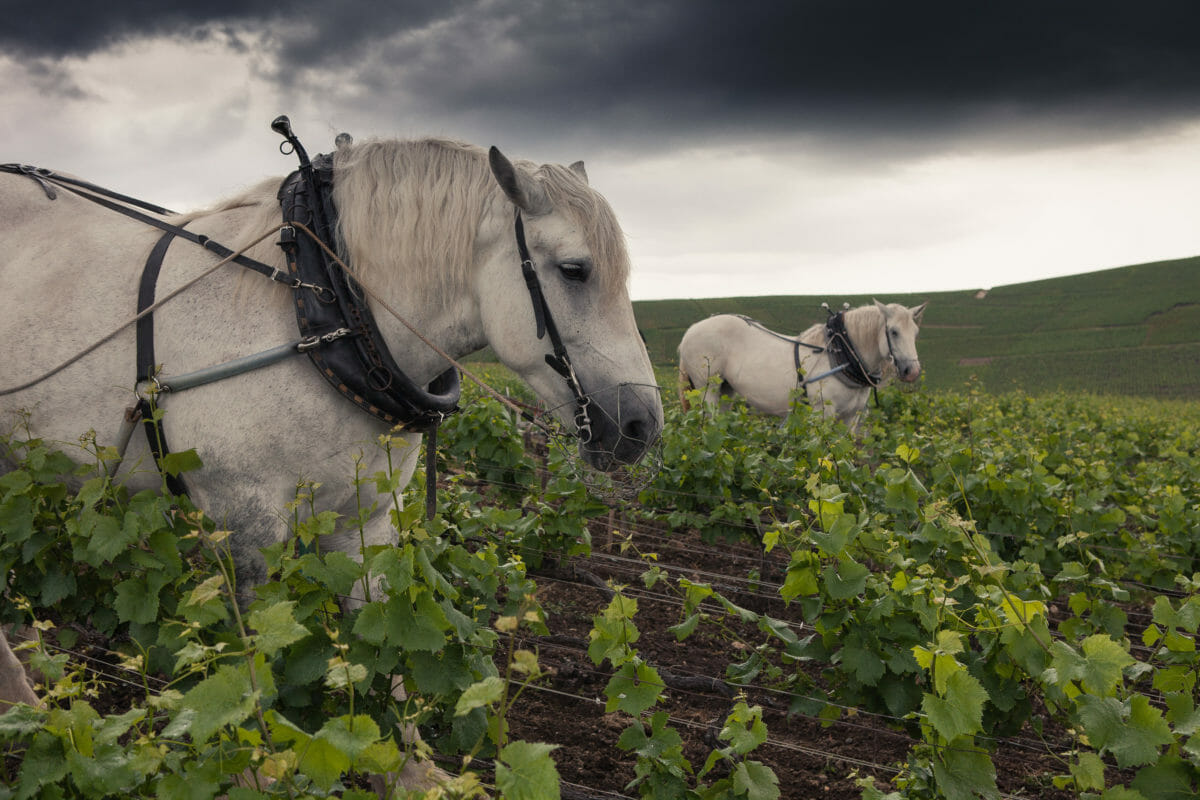How a 244-year-old champagne house readied its vineyards for climate change.

The grapevines that grow in the fields of French Champagne producer Louis Roederer are hardy plants. They are descended from the survivors of a July 1709 freeze that killed off 600,000 of 800,000 hectares of vineyards throughout the region, followed by a late 19th-century heat wave with temperatures as warm as today’s.
Knowing this, two decades ago, the head winemaker at Louis Roederer, Jean-Baptiste Lécaillon, began renovating the viticulture practices of the vineyards under his care from, well, the ground up. Unhindered by a corporate board (in Reims, Champagne houses farming hundreds of hectares have a tendency to come under luxury conglomerate ownership), the winemaker got the go-ahead from his boss, Frédéric Rouzaud, the seventh-generation member of his family to run Roederer, to figure out how to go organic.
Lécaillon’s first stop was Australia, where for three years he steeped himself in the agricultural practices of biologist Bill Mollison, widely considered the father of permaculture. He returned to Reims to start experimenting with farming practices not used in the region since the early 1970s and, often, much earlier. Today, as Roederer sees the fruits of the winemaker’s two-decade effort in the bottles of its first fully organic vintages, those hardy vines’ descendants are incidentally even better prepared than their ancestors to cope with increasingly extreme swings in weather.
Climate change, however, wasn’t Lécaillon’s leading concern back in 2000. Rather than experimenting first with the parcels that produce Brut Premier, the house’s most gently priced bubbles, Lécaillon started at the top, with the twenty-plus-year-old vines destined to become Cristal, a Champagne known for retailing in the low three digits. “At that price, I just don’t feel comfortable not being organic,” Lécaillon admits. Since then, he has worked his way downward, and at present, 115 hectares of the vineyard are under organic certification, with the other 115 biodynamically farmed, making Roederer by far the largest Champagne house to operate under such practices.
In contrast to his tendency to effect drastic change, Lécaillon comes off as sanguine, an attitude that extends even to the three years of a 30-percent drop in yield that resulted from quitting herbicides all at once. “You catch up later,” he says. With a tractor—and, sometimes, a horse, for particularly delicate young and old plants—tilling competitive grasses and cutting “lazy roots,” the vines grew stronger and farther downward, to the chalk that gives Champagne its unique flavor. During this initial period, “it was important to let the soil breathe and re-develop its full identity,” he says.

Photo by Eric Zeziola.
After four years, the vines could withstand quitting insecticides, followed by a fungicide used against the fungus botrytis. Rose bushes were planted as a test for downy mildew, and the house started buying manure from organic cattle farms to make its own compost (“everybody thinks you feed the vine, but you feed the soil,” Lécaillon points out). Depending on the position of the moon, vines stressed by strategic cutting are soothed with chamomile tea, hand-sprayed from a backpack in the early morning. Turning to the winemaking process itself, Lécaillon began to use wild yeast from the fields to kick off fermentation, despite its inconsistency compared to the commercial yeast standard for sparkling wine. “Sometimes, the yeast wants to ferment in ten days, sometimes a month,” he says. “It’s fine, they do what they want.”
Likewise left to nature are the roots themselves, once again surrounded by healthy fungus, worms and bacteria that efficiently “transfer the mineral world into the vegetable world,” says Lécaillon. These deep roots have turned out to be both less reactive to excessive summer rainfall and more resistant to increasing heat, since the farther down into the earth you go, the winemaker notes, “the fresher the conditions.” For the final, drinkable product, this matters, too—after all, he says, “eighty-five percent of the wine is water coming from the soil!” The top-to-bottom conversion has let Lécaillon achieve his other goal, recreating the flavor of Champagne from the 1950s and 60s. “People wanted to be happy, and when you’re happy, you make good wines,” he says. But human joy aside, this post-war era also represents the final period before chemical-driven farming took hold throughout the region, practices Lécaillon has taken twenty years to finally undo.
What a wonderfully positive and hopeful story in the face of conventional (today) wisdom that you MUST have pesticides to be able to grow grapes successfully. I applaud Mr. Lecaillon as well as his boss for taking this bold step, and wish them every success.
It’s fine they are doing it, but they are hardly innovators taking a bold step. Especially in France, natural wine pioneers like Jules Chauvet, Nicolas Joly, Olivier Cousin, etc. etc. were working this territory long before. Roederer’s PR department may want to paint themselves as leaders in the movement toward non-harmful vineyard practices, but that ground was covered long before M. Lécaillon made his “discovery.” Good they are following the lead of other innovators, but credit where credit is due. Although I suppose that’s not a “good marketing strategy.”
Big or small, new or old, any person or company that is working to create a more regenerative, adaptable agricultural system should get our support. It took pioneers like Jules Chauvet had to make some noise to get this thing rolling in the right direction – effort that absolutely need credit. And it worked, because this big, fancy champagne house just flipped their star vineyards in the right direction. Now if we can only get more big ag to follow suite!